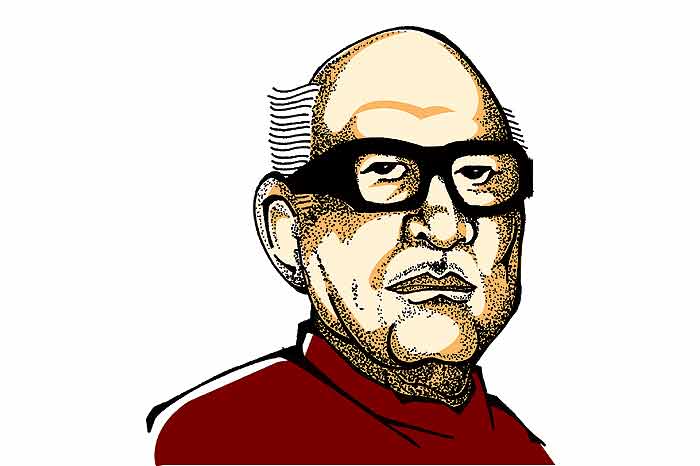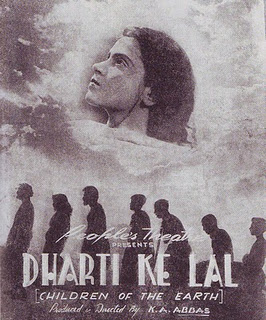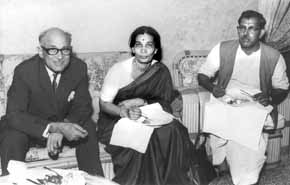| Version 22 (modified by , 12 years ago) (diff) |
|---|
Khwaja Ahmad Abbas
Hindi-Urdu director and scenarist mainly in the socialist-realist mode.
Early Life
Early life and education
Khwaja Ahmad Abbas was born in Panipat, Haryana. He was born in the home of celebrated Urdu poet, 'Khwaja Altaf Husain Hali', a student of Mirza Ghalib. His grandfather Khwaja Gulam Abbas was one of the chief rebels of the 1857 Rebellion movement, and the first martyr of Panipat to be blown from the mouth of a cannon. Abbas's father Ghulam-Us-Sibtain graduated from Aligarh Muslim University, was a tutor of a prince and a prosperous businessman, who modernised the preparation of Unani medicines. Abbas's mother, 'Masroor Khatoon', was the daughter of Sajjad Husain, an enlightened educationist. Abbas took his early education in 'Hali Muslim High School', which was established by his great grand father Hali. He had his early education till 7th in Panipat. He was instructed to read the Arabic text of the Quran and his childhood dreams swung at the compulsive behest of his father. Abbas completed his matriculation at the age of fifteen. He did his B.A. with English literature in 1933 and LL.B. in 1935 from Aligarh Muslim University
Worked on National Call, a New Delhi paper (1933); started Aligarh Opinion when studying law (1934); obtained law degree in 1935; political correspondent and later film critic for nationalist Bombay Chronicle, Bombay (1935- 47) praising Dieterle, Capra and esp. Shantaram. Wrote Indian journalism’s longest- running weekly political column, Last Page (1941-86), in Chronicle and Blitz. Best-known fiction (Zafran Ke Phool situated in Kashmir, Inquilab on communal violence) places him in younger generation of Urdu and Hindi writers with Ali Sardar Jafri and Ismat Chughtai, whose work followed the PWA? and drew sustenance from Nehruite socialism’s pre- Independence, anti-Fascist and anti-communal commitments. Founder member of IPTA’s all- India front (1943), to which he contributed two seminal plays: Yeh Amrit Hai and Zubeida. Entered film as publicist for Bombay Talkies (1936) to whom he sold his first screenplay, Naya Sansar (1941). First film, Dharti Ke Lal, made under IPTA’s banner and drew on Bijon Bhattacharya’s classic play Nabanna (1944), dealing with the Bengal famine of 1943.
Set up production company Naya Sansar (1951), providing India’s most consistent representation of socialist-realist film (cf. Thoppil Bhasi and Utpal Dutt). Best work is in the scripts for his own films and for those of Raj Kapoor (Awara 1951); Shri 420 (1955), 1955, both co-written with V.P. Sathe; Jagte Raho, 1956; Bobby, 1973) and Shantaram’s Dr. Kotnis Ki Amar Kahani (1946; adapted from his own book, And One Did Not Come Back), which combined aspects of Soviet cinema (Pudovkin) and of Hollywood (e.g. Capra and Upton Sinclair), influencing a new generation of Hindi cineastes (Kapoor, Chetan Anand) and sparking new realist performance idioms (BALRAJ SAHNI). His Munna, without songs or dances, and Shaher Aur Sapna, cheaply made on location in slums, were described as being influenced by neo-realism. Pardesi is the first Indian-Soviet co-production, co- directed by Vassili M. Pronin. The landmark Supreme Court censorship judgement about his Char Shaher Ek Kahani (aka A Tale of Four Cities) curtailed ‘arbitrary’ governmental pre- censorship powers on the grounds that the Indian Constitution guarantees the right to free speech. His constitutional challenge of the Cinematograph Act led to the famous Supreme Court decision upholding the validity of precensorship of cinema. Interestingly in Interestingly in 1939, K A Abbas had written a letter to Gandhi urging him to reconsider his opinion on the idea of the evil of cinema. He writes
“Today I bring for your scrutiny - and approval -a new toy my generation has learned to play with, the CINEMA! – You include cinema among evils like gambling, sutta, horse racing etc... Now if these statements had come from any other person, it was not necessary to be worried about them... But your case is different. In view of the great position you hold in this country, and I may say in the world, even the slightest expression of your opinion carries much weight with millions of people. And one of the world's most useful inventions would be allowed to be discarded or what is worse, left alone to be abused by unscrupulous people. You are a great soul, Bapu. In your heart there is no room for prejudice. Give this little toy of ours, the cinema, which is not so useless as it looks, a little of your attention and bless it with a smile of toleration”.
Published many books including I Am Not An Island and Mad Mad World of Indian Films (both 1977). Other important scripts: Neecha Nagar (1946); Mera Naam Joker (1970); Zindagi Zindagi (1972); Henna (1991). Abbas also brought a number of new talents into the film industry, such as Amitabh Bachchan in Saat Hindustani.
Filmography:
1946: Dharti Ke Lal;
1947: Aaj Kal Aur Aaj
1952: Anhonee; Rahi/Two Leaves And A Bud;
1954: Munna;
1957: Pardesi;
1959: Char Dil Char Raahein;
1960: Id Mubarak (Sh);
1961: Gir Game Sanctuary (Doc);
1962: Gyarah Hazaar Ladkiyan;
1963: Shaher Aur Sapna; Teen Gharaney;
1964: Hamara Ghar;
1965: Aasmaan Mahal; Tomorrow Shall Be Better (Sh);
1967: Dharti Ki Pukaar (Sh); Bambai Raat Ki Bahon Mein;
1968: Char Shaher Ek Kahani (Doc);
1969: Saat Hindustani; 1971: Do Boond Pani; Lav Kush (Sh);
1972: Bharat Darshan (Doc);
1973: Kal Ki Baat (Sh); Juhu (TV-Sh); 1974: Faasla;
1975: Papa Miyan of Aligarh (Doc);
1976: Phir Bolo Aaye
Extras
Abbas began his career as a journalist, when he joined 'National Call', a New Delhi based paper after his finishing his B.A.. Later while studying law in 1934, started 'Aligarh Opinion', India's first university students' weekly during the pre-independence period.
After completing his education at Aligarh Muslim University, Abbas joined the Bombay Chronicle in 1935. He occasionally served a film critic, but after the film critic of the paper died, he was made the editor of the film section.
He entered films as a part time publicist for Bombay Talkies in 1936, a production house owned by Himanshu Rai and Devika Rani, to whom he sold his first screenplay Naya Sansar (1941).[3]
While at the Bombay Chronicle, (1935–1947), he started a weekly column called 'Last Page', which he continued when he joined the Blitz magazine.[1] "The Last Page", (‘Azad Kalam’ in the Urdu edition), thus became the longest-running political column in India's history (1935–87).[4] A collection of these columns was later published as two books. He continued to write for The Blitz and Mirror till his last days.
Meanwhile he had started writing scripts for other directors, Neecha Nagar for Chetan Anand and Dr. Kotnis Ki Amar Kahani for V. Shantaram.
In 1945, he made his directorial debut with a film based on the Bengal famine of 1943, Dharti Ke Lal (Children of the Earth) for the Indian People's Theatre Association (IPTA). In 1951, he founded his own production company called Naya Sansar, which consistently produced films that were socially relevant including, Anhonee, Munna, Rahi (1953), based on a Mulk Raj Anand story, was on the plight of workers on tea plantations, the National Film Award winner, Shehar Aur Sapna (1964) and Saat Hindustani (1969), which won the Nargis Dutt Award for Best Feature Film on National Integration and is also remembered as Bollywood icon, Amitabh Bachchan's debut film.
A prolific writer, and novelist, during his illustrious career spanning five decades, Abbas wrote over 73 books in English, Hindi and Urdu.[5] Abbas was considered a leading light of the Urdu short story.[6] His best known fictional work remains 'Inquilab', based Communal violence, which made him a household name in Indian literature.[7] Like Inquilab, many of his works were translated into many Indian, and foreign languages, like Russian, German, Italian, French and Arabic.
Abbas interviewed several renowned personalities in literary and non-literary fields, including the Russian Prime Minister Khrushchov, American President Roosevelt, Charlie Chaplin, Mao-Tse-Tung and Yuri Gagarin.
He went on to write scripts for Jagte Raho, and most of the prominent Raj Kapoor films including Awaara, Shri 420, Mera Naam Joker, Bobby and Henna.
His autobiography, I Am not an Island: An Experiment in Autobiography, was first published in 1977 and later released in 2010.[2]
Awards and honours
1964: National Film Award for Best Film: Shehar Aur Sapna
1946: Wrote screenplay, for Neecha Nagar, which became the only Indian film to win a Palme d'Or (Golden Palm) at the Cannes Film Festival.
1942: BFJA Awards: Best Screenplay: Naya Sansar (1941)[8]
1957 Cannes Film Festival: Golden Palm: Pardesi: Nominated [9]
1964: Maharashtra State Award: Fakira
1965: International Film Festival Awards (Santa Barbara, USA)): Hamara Ghar[10]
1966: Jury Member: 16th Berlin International Film Festival[11]
1970: Nargis Dutt Award for Best Feature Film on National Integration: Saat Hindustani
1972: Nargis Dutt Award for Best Feature Film on National Integration: Do Boond Paani
1980: Gold Award for direction: The Naxalites
Resources
A tribute to Abbas by Carol Singo
A tribute from Nawam Zamana
A two part interview with Abbas which recounts his early years and the early history of cinema in India
Attachments
-
abbs.jpg
 (28.6 KB) -
added by 13 years ago.
(28.6 KB) -
added by 13 years ago.
-
dharti ke lal.jpg
 (36.4 KB) -
added by 13 years ago.
(36.4 KB) -
added by 13 years ago.
-
abbas2.jpg
 (12.4 KB) -
added by 13 years ago.
(12.4 KB) -
added by 13 years ago.


